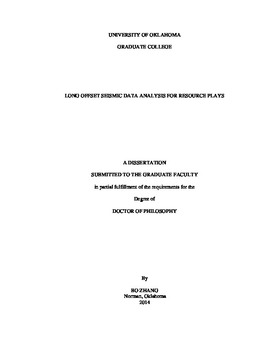| dc.description.abstract | Wide-azimuth, long-offset seismic surveys are becoming increasingly common in unconventional exploration plays, where three the key objectives are to estimate the direction of maximum horizontal stress, to predict the intensity and orientation of any fractures, and to differentiate brittle from ductile lithology.
Minimization of NMO and migration stretch, which usually appears at long offset, is one of the main issues for long-offset seismic processing. The stretch not only lowers the seismic resolution, but also hinders subsequent prestack inversion such as lambda-rho (λρ), mu-rho (μρ), and amplitude variation with offset and azimuth (AVAz) analysis of the long-offset signal. The first part of this dissertation uses a matching pursuit based normal moveout correction (MPNMO) to reduce NMO-stretch effect in long offset data.
Nonhyperbolic velocity analysis is components for long-offset seismic processing. Conventional migration velocity analysis mainly has two limitations. First we need to interpolate the velocity and anisotropy parameters along spatial and temporal axes between adjacent manually picked locations. Such interpolation can smooth over any intermediate velocity and anisotropy anomalies contained in the gathers. Second, smoothed RMS velocities can give rise to unacceptable interval velocities using the simple Dix equation. I developed an automated nonhyperbolic velocity analysis workflow in the second part of this dissertation that uses the conventional analysis as a starting estimate.
The third part of this dissertation illustrates a workflow to preserve the data fidelity for far offset seismic gathers. The workflow begins by performing reverse NMO on the time migrated gathers using the initial migration velocity. Then I obtain the optimal velocity and anellipticity model using a differential evolutionary automatic algorithm. Next I apply nonstretch NMO correction to the time migrated gathers using the new velocity and anellipticity model resulting in flattened nonstretched prestack gathers. Finally, I apply prestack structure oriented smoothing algorithm to further improve the signal to noise ratio. In this manner, both stacking power and vertical resolution are improved by aligning the data and by avoiding stretch, and removing migration aliasing artifacts.
The fourth part of this dissertation proposed a strategy to evaluate brittleness of unconventional resources plays by integrating petrophysics and seismic data analysis. I start by computing rock properties and brittleness index (BI) from mineral content logs. Then I define a classification pattern between rock properties and BI using proximal support vector machine training and testing on the selected benchmark wells. Next I perform simultaneous prestack inversion using commercial software on the prestack conditioned seismic gathers. Finally, I estimate 3D brittleness evaluation for the target reservoirs by applying the recognized classification pattern to the prestack inversion volumes.
The final part of my dissertation focuses on automatic fault surfaces extracting using seismic attributes. The extracting procedure is modeled after a biometric algorithm to recognize capillary vein patterns in human fingers. First, a coherence or discontinuity volume is converted to binary form indicating possible fault locations. This binary volume is then skeletonized to produce a suite of fault sticks. Finally, the fault sticks are grouped to construct fault surfaces using a classic triangulation method. The processing in the first two steps is applied time slice by time slice, thereby minimizing the influence of staircase artifacts seen in discontinuity volumes. | en_US |
